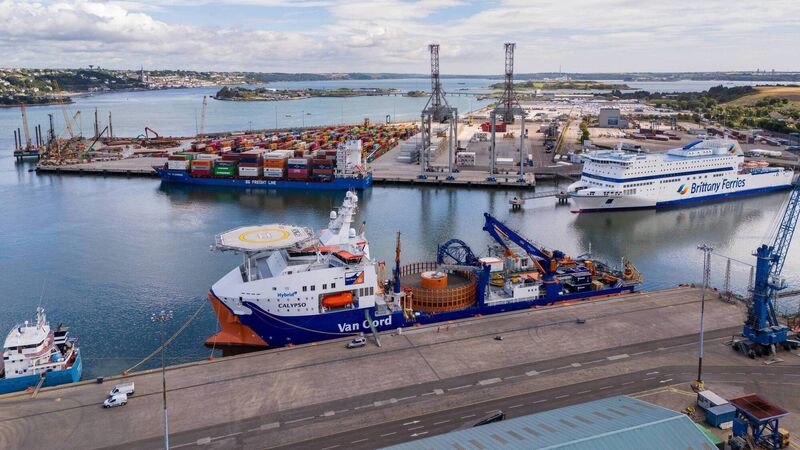Work starts on Celtic Interconnector as ship arrives in Cork to lay underwater cable

A specialist marine vessel, Calypso, arrived from Norway into the Port of Cork this week.
Work laying the underwater cable for the first electricity interconnector between Ireland and mainland Europe has begun.
It marks a major milestone in the huge €1bn Celtic Interconnector scheme to link the electricity grids of the two countries.
A specialist marine vessel, Calypso, arrived from Norway into the Port of Cork this week, with a huge cable spool on its deck, to begin laying an 84km section of the estimated 500km of high voltage direct current (HVDC) cable required to link the coast of East Cork and Brittany in northern France.
While Ireland and France both use high voltage alternative current (HVAC) technology to move electricity around their networks and supply consumers, HVDC technology is best for moving electricity over long distances.
The crew of the Calypso will lay HVDC cable on the seabed but it will be buried by two other vessels. The work is weather sensitive and is being done in summer to maximise the best weather conditions.
Marine survey teams have already mapped the seabed to chart the best route for the cable, and EirGrid said it is liaising with local fisheries and marine users throughout the work.

Once fully installed, the entire 575km Celtic Interconnector will run from East Cork to the north-west of Brittany and will allow for the exchange of 700MW of electricity - enough to power some 450,000 homes.
On the Irish side, the cable will make landfall at Youghal, where work has been underway at Claycastle Beach in recent weeks to prepare its landing point.
The project has also involved extensive cable installation work along roadsides and through fields across East Cork to transfer the electricity from the landing point at Youghal to a massive new convertor station which has been built at Ballyadam, near Carrigtwohill, where internal fitout is continuing, and onwards to a grid connection point in Knockraha.
The convertor building will convert the HVDC electricity arriving from France to HVAC for use in the Irish network, and vice versa for the power that may be exported from Ireland to France. Similar onshore work is ongoing in Brittany.
The Celtic Interconnector project is being developed by EirGrid, which operates and develops Ireland’s electricity grid, and its French equivalent, Réseau de Transport d’Electricité (RTÉ), and is being co-funded by the EU Connecting Europe Fund.

EirGrid’s chief financial officer, Michael Behan, said the start of this crucial phase of the project really shows the progress being made on what is a key energy project for Ireland.
“This feat of engineering that will take place over the coming weeks is testament to the collaboration, innovation and care required to deliver this critical infrastructure,” he said. “We remain grateful for the continued patience and support of communities, landowners, and stakeholders as we progress this project.”
It is estimated that construction of the entire project will be complete by 2028, a delay on original timelines which EirGrid has blamed partly on weather conditions at times.















